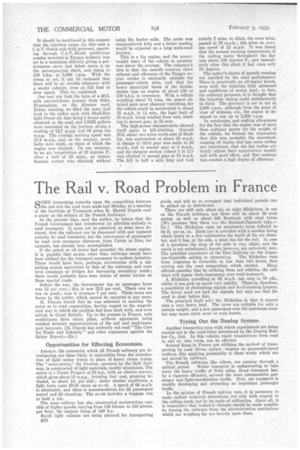The Rail v. Road Problem in France
Page 42

If you've noticed an error in this article please click here to report it so we can fix it.
SOME interesting remarks upon the competition between the rail and the road were made last Monday at a meeting of the Institute of Transport when M. Marcel Dupuis read a paper on the subject of the French Railways.
At the present time, said the author, he feared that the French Government had transferred its affection entirely to road transport. It must not be admitted, as some have dedared, that the railways can be dispensed with and replaced entirely by road transport, but the conveyance of passengers by road over enormous distances, from Calais to Nice, for example, has already been accomplished.
If the petrol or oil motor had preceded the steam engine, it is possible that means other than railways would have been utilized for the transport necessary to modern industry. There would have been, perhaps, autostradas with a signalling system equivalent to that of the railways, and even level crossings or bridges for traversing secondary roads ; there would probably have been trains of motor lorries on these special roads.
Before the war, the Government tax on passenger fares was 12 per cent.; this is now 32.5 per cent There was no tax on goods ; now it averages 7 per cent. These taxes are borne by the public, which cannot be expected to pay more.
M. Dupuis stated that he was ashamed to mention the point as to road competition, having regard to the magnificent way in which the problem had been dealt with, and even solved, in Great Britain. TJp to the present in France, only conferences have taken place, without agreement being reached between representatives of the rail and road-transport interests. [M. Dupuis has evidently not read "The Case for Trade and Industry" and other arguments against the Salter Report.—En.
Opportunities for Effecting Economies.
Amona:st the economies which all French railways are investigating are those likely to materialize from the introduction of light motor trains in place of heavy steam trains. The " automotrice," the Pauline, operated by the Midi Railway, is constructed of light materials, mostly aluminium. The motor is a Diesel Peugeot of 70 h.p., with an electric starter, which gives about 18 m.p.g., bringing fuel cost, greasing included, to about 4cl. per mile; under similar conditions, a light train costs 20-25 times as much. A speed of 66 m.p.h. is obtainable' and there is accommodation for 55 passengers seated and 20 standing; The co:-,ch includes a baggage van to hold a ton.
The same railway has also constructed automotrices capable of higher speeds, varying from 130 kiloms. to 150 kiloms, per hour, the engines 'being of LOO h.p.
Small light railears are being planned for transporting E28 goods, and will be so arranged tnat individual parcels can be picked up or distributed.
There are still only about six or eight Miehelines in use on the Fre ach railways, but there will be about 20 next spring as well as about 100 Sentinels with steel tyres. [We presume that these Pie the Sentinel-Cammell type.— En.] The Micheline runs on pneumatic tyres inflated to 84 lb. per sq. in. Each tyre is provided with a wociden lining which limits to a few centimetres the depth of the air chamber, and it has, at the side, a steel rim for the rail. In case of a puncture the drop of the axle is very slight, and the coach is not unbalanced ; bursts, however, are extremely rare. The practical experienee. of the Etat Railway on the Argen tan-Granville section is interesting. The Micheline runs from Argeatan to Granville in less than two hours, thus cutting out the road competition which existed. Many officials consider that by utilizing these rail vehicles, the railways will regain their supremacy over road transport.
A Micheline travelling at 62 m.p.h. can stop in 88 yds., whilst it can pick up speed very rapidly. There is, therefore, a possibility of eliminating signals and lard-crossing keepers. The driver need not look for signals, but only see that the road is clear before him.
The principal fault wit'i the Micheline is that it cannot take a sety heavy load. The tyres are suitable for only a certain weight, and a few passengers over the maximum number may cause extra wear or even bursts.
Trying Out the Dunlop System.
Another interesting type with which experiments are being carried out is the road-railer introduced by the Dunlop Rubber Co., Ltd. In this vehicle; rapid transference from road to rail or, vice versa, can be effected. Several firms in Prance are utilizing the method of transporting by road 10-ton rallwa: wagons on pneumatic-tyred trolleys, this applying principally to those works which are not served by railways.
The French railways, like others, are passing through a critical period. Water transport is endeavouring to take away the heavy traffic of little value. Road transport has, by a vigorous offensive, secured the most remunerative passenger and light-merchandise traffic. Now, air transport is rapidly developing and attracting an important passenger traffic.
In the opinion of French railway men, it is necessary to make radical technical alterations, not only -with respect to the rolling stock, laufin its mode of utilization. Above all, it is imperativa that technical changes should be made possible by freeing the railways from the administrative restrictions which are weighing far too heavily upon them.




























































































